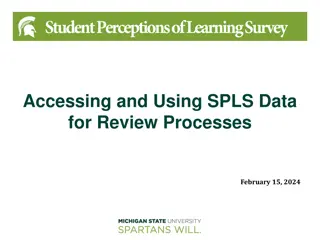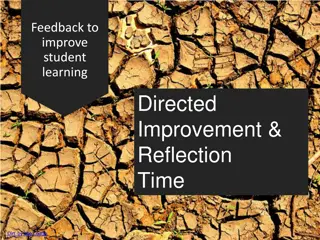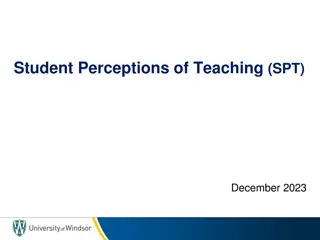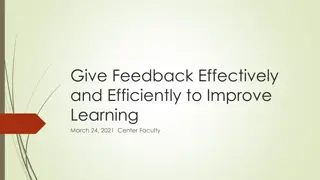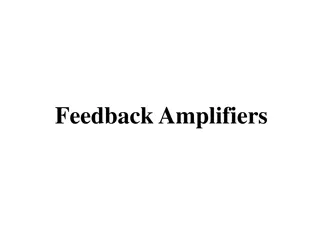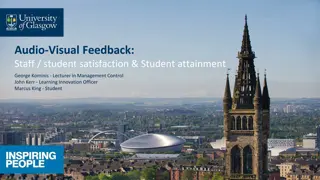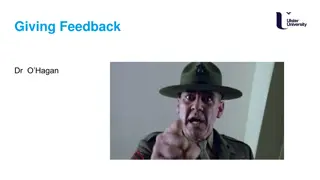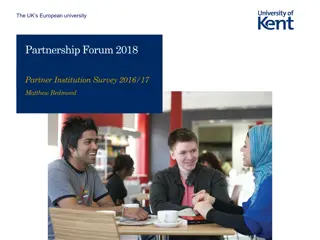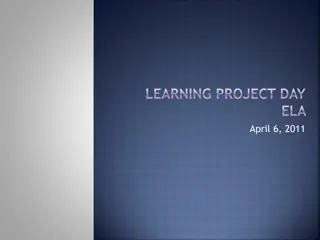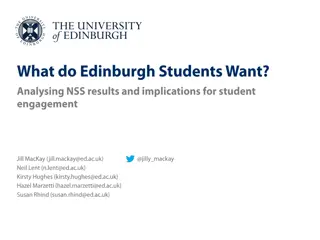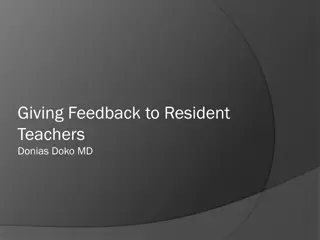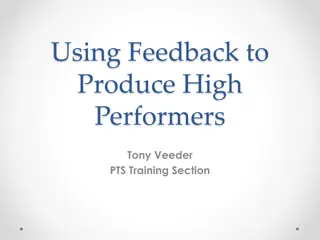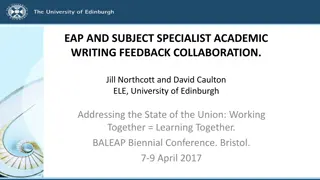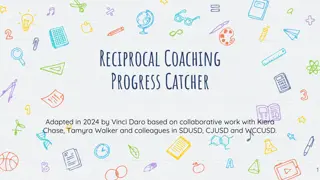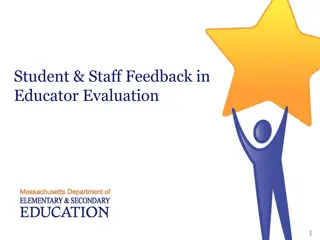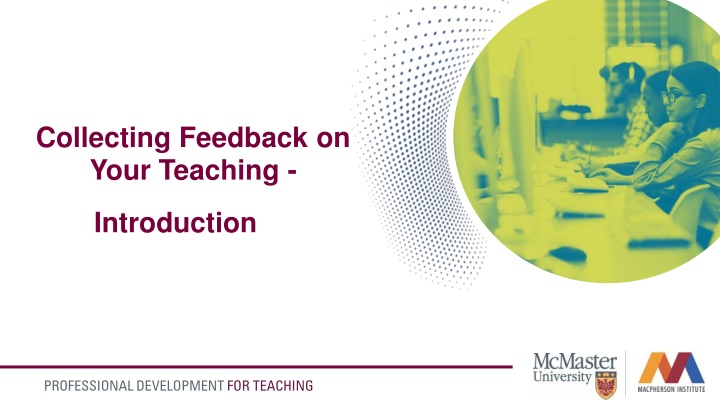
Effective Strategies for Collecting Feedback in Teaching
Enhance your teaching skills by collecting valuable feedback from students. Learn the importance of feedback, when and how to collect it, and how to leverage it to improve your teaching methods. Explore formative versus summative feedback, the significance of student feedback, and tips for maximizing the effectiveness of feedback collection in education.
Download Presentation

Please find below an Image/Link to download the presentation.
The content on the website is provided AS IS for your information and personal use only. It may not be sold, licensed, or shared on other websites without obtaining consent from the author. If you encounter any issues during the download, it is possible that the publisher has removed the file from their server.
You are allowed to download the files provided on this website for personal or commercial use, subject to the condition that they are used lawfully. All files are the property of their respective owners.
The content on the website is provided AS IS for your information and personal use only. It may not be sold, licensed, or shared on other websites without obtaining consent from the author.
E N D
Presentation Transcript
Collecting Feedback on Your Teaching - Introduction PROFESSIONAL DEVELOPMENT FOR TEACHING
I've been [collecting student feedback] for more than ten years. Sometimes I laugh, sometimes I cry -- and sometimes I'm mortified. But I can honestly say that every single piece of feedback I've received has made me a better teacher. And great teachers are never afraid of having or inviting hard conversations. This is one of best practices that has helped me to be a better, more excited teacher every year. - Vicki Davis, College Instructor, Georgia PROFESSIONAL DEVELOPMENT FOR TEACHING
Reflect: Why should you collect feedback on your course and teaching? When do you collect feedback on your teaching? PROFESSIONAL DEVELOPMENT FOR TEACHING
Reflect: Consider feedback you've received in the past. Did it meet your needs? How effective was that feedback in improving your teaching? What about it made it effective or ineffective? PROFESSIONAL DEVELOPMENT FOR TEACHING
Formative vs. Summative feedback PROFESSIONAL DEVELOPMENT FOR TEACHING
Why collect student feedback? How are students responding to your teaching approaches? Why might they be responding this way? How can you refocus your teaching methods to help students learn more efficiently and effectively? How can you achieve more highly rated teaching evaluations? PROFESSIONAL DEVELOPMENT FOR TEACHING
When collect student feedback? Mid-term! But why? Allows you to understand what is working well for the students, and affirms your pedagogical decisions Allows you to understand what is not working well, while still giving you time to make changes for the current cohort of students Tip: collect the feedback at the beginning of class Students will be more reflective in their responses, considering the whole semester rather than the first half of the class Students are more likely to complete the feedback PROFESSIONAL DEVELOPMENT FOR TEACHING
Considering Mid-term Student Feedback Summative course evaluations have been increasingly critiqued in recent years doesn't lead to significant improvements in teaching (Hendry & Dean, 2002) demonstrates high levels of bias(Boring, Ottoboni & Stark, 2016; Freishtat, 2016) Few teachers use summative course evaluations to improve their teaching (Golding & Adam, 2016) Mid-term student feedback is increasingly recognized as a beneficial method to gather constructive feedback on both student learning and the student experience(Finelli et al., 2011; Snooks et al., 2007; Veeck et al., 2016) Mid-term student feedback usually leads to an increased rating of instructional skills by students at the end of the term (Cohen, 1980; Knol et al., 2013) PROFESSIONAL DEVELOPMENT FOR TEACHING
Benefits Feedback can be oriented entirely towards instructor development since it is not being used for a secondary purpose (Kember, Leung, & Kwan, 2002; Penny, 2003) Promotes two-way communication with learners on instructional design and decision making" (Diamond, 2004) Students also recognize that mid-term student feedback is not a mandatory exercise, and so are more likely to "participate authentically" (Springgay & Clarke, 2007) Shifts role dynamics between Instructors/TAs and students: the students assess and provide feedback, and the Instructor/TA demonstrates what they learned (Taylor et al., 2020) Students are more satisfied with mid-term student feedback than end of term feedback (Abbott et al., 1990; Hunt, 2003) PROFESSIONAL DEVELOPMENT FOR TEACHING
Challenges Time! (Taylor et al., 2020) It takes up instructor time during the term and may take time out of a class or synchronous teaching session. Depending on how the feedback tool is designed, student responses can be time consuming to read Student anonymity needs to be assured in order to obtain honest student responses May lead to student frustration if nothing is done with the feedback in the second half of term Most effective with consultation (Cohen, 1980; Knol et al., 2013; Kulik, 2001) Note: Many of these challenges can be addressed, at least partially, by how you design your mid-term feedback process PROFESSIONAL DEVELOPMENT FOR TEACHING
References Abbott, R. D., Wulff, D. H., & Szego, C. K. (1990). Satisfaction with processes of collecting student opinions about instruction: The student perspective. Journal of Educational Psychology, 82(2), 201 206. https://doi.org/10.1037/0022-0663.82.2.201 Boring, A., Ottoboni, K., & Stark, P. B. (2016). Student evaluations of teaching (mostly) do not measure teaching effectiveness. ScienceOpen Research. https://doi.org/10.14293/S2199-1006.1.SOR-EDU.AETBZC.v1 Cohen, P. A. (1980). Effectiveness of student-rating feedback for improving college instruction: A meta-analysis of findings. Research in Higher Education, 13(4), 321 341. https://doi.org/10.1007/BF00976252 Diamond, R. M. (2004). Preparing for promotion, tenure, and annual review: A faculty guide. Anker Publishing. Finelli, C. J., Pinder-Grover, T., & Wright, M. C. (2011). Consultations on teaching: Using student feedback for instructional improvement. To Improve the Academy, 29(1), 283 297. https://doi.org/10.1002/j.2334- 4822.2011.tb00664.x Freishtat, R. (2016). The utility of student evaluations of teaching. Berkeley Center for Teaching & Learning. https://teaching.berkeley.edu/news/utility-student-evaluations-teaching PROFESSIONAL DEVELOPMENT FOR TEACHING
References Golding, C., & Adam, L. (2016). Evaluate to improve: Useful approaches to student evaluation. Assessment & Evaluation in Higher Education, 41(1), 1 14. https://doi.org/10.1080/02602938.2014.976810 Hendry, G. D., & Dean, S. J. (2002). Accountability, evaluation of teaching and expertise in higher education. International Journal for Academic Development, 7(1), 75 82. https://doi.org/10.1080/13601440210156493 Hunt, L. (2003). Encouraging student evaluations of teaching. Innovations in Education and Teaching International, 40(3), 287 299. https://doi.org/10.1080/1470329032000103807 Kember, D., Leung, D. Y. P., & Kwan, K. P. (2002). Does the use of student feedback questionnaires improve the overall quality of teaching? Assessment & Evaluation in Higher Education, 27(5), 411 425. https://doi.org/10.1080/0260293022000009294 Knol, M. H., Dolmans, D. H. J. M., van der Vleuten, C. P. M., & Kooloos, J. G. M. (2013). The effects of a midterm evaluation of teaching on student satisfaction and learning in a problem-based learning curriculum: A quasi- experimental study. Advances in Health Sciences Education, 18(5), 797 808. https://doi.org/10.1007/s10459-012- 9415-7 PROFESSIONAL DEVELOPMENT FOR TEACHING
References Kulik, J. A. (2001). Student ratings: Validity, utility, and controversy. New Directions for Institutional Research, 2001(109), 9 25. https://doi.org/10.1002/ir.1 Penny, A. R. (2003). Changing the agenda for research into students' views about university teaching: Four shortcomings of SRT research. Teaching in Higher Education, 8(3), 399 411. https://doi.org/10.1080/13562510309396 Springgay, S., & Clarke, A. (2007). Learning to teach: A body becoming curriculum. Peter Lang. Taylor, R. L., Knorr, K., Ogrodnik, M., & Sinclair, P. (2020). Seven principles for good practice in midterm student feedback. International Journal for Academic Development, 25(4), 322-336. https://doi.org/10.1080/1360144X.2020.1821570 Veeck, A., O'Reilly, K., MacMillan, A., & Yu, H. (2016). The use of collaborative midterm student evaluations to provide actionable results. Journal of Marketing Education, 38(3), 157 169. https://doi.org/10.1177/0273475316661864 PROFESSIONAL DEVELOPMENT FOR TEACHING

